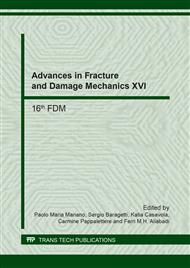p.252
p.256
p.260
p.264
p.268
p.272
p.279
p.283
p.287
Evaluation of Residual Stresses in Butt Welded Joint of Dissimilar Material by FEM
Abstract:
The study proposed within this paper deals with an application of finite element techniques to the thermo-structural analysis of a dissimilar butt-welded joint. Residual stresses induced by the fusion arc-welding of steel joints in power generation plants are a concern to the industry. Nowadays, the application of finite element method appears to be a very efficient method for the prediction and the investigation of the weld-induced residual stresses, nevertheless the detailed modelling of all phenomena involved in such process is still challenging. The structural integrity assessment of welded structures strongly requires a deep investigation of weld-induced residual stresses in order to be compliant with safety requirement of power plant. The longitudinal and transversal residual stresses in dissimilar material butt joints of 8 mm thick for V-groove shape were studied. The developed thermo-mechanical FE model as well as the simulation procedures are detailed and results are discussed. As a result of such work, it has been found out that residual stresses in the two dissimilar plates are characterized by very different magnitudes and distribution.
Info:
Periodical:
Pages:
268-271
Citation:
Online since:
September 2017
Authors:
Keywords:
Price:
Сopyright:
© 2017 Trans Tech Publications Ltd. All Rights Reserved
Share:
Citation:


